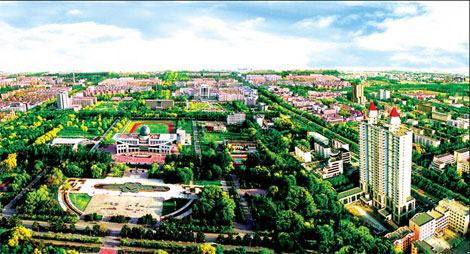News
Forestation holds back the encroaching desert
By Shao Wei (China Daily)
Updated: 2010-11-29 07:59
 |
Large Medium Small |
|
Shihezi, a key city in Xinjiang, enjoys rapid development and is a prime example of the construction effort of XPCC. |
SHIHEZI, Xinjiang - The Xinjiang Production and Construction Corps (XPCC), known as Bingtuan, is a quasi-military, governmental organization in the Xinjiang Uygur autonomous region.
After the State started its western development program in 1999, the XPCC has tried to be an "ecological warrior" and increased forestation on 242,000 hectares in the Gobi desert.
As the Xinjiang Tianye Group, a flagship enterprise of the XPCC, and the city of Shihezi, the birthplace of the XPCC, were designated part of a national circular economy pilot project.
The recycled use of industrial solid waste in 2010 increases by 30 percentage points over 1999, and the recycling of industrial waste water increases by 25 percentage points.
Environmental protection has improved both the working and living conditions of XPCC.
In its early days, under a principle of "not competing for benefits with the local people", the XPCC worked on water conservation and reclaimed wasteland along the northern and southern edges of the Tianshan Mountains under adverse conditions.
The group has 88 stock breeding farms on the rim of the Taklimakan and Gurbantunggut deserts, 58 farms scattered along 2,000 km of borders with Tajikistan, Russia, and other countries, as well as others in the Gobi Desert, putting it on the frontline against the encroaching sand.
Over the past decade, the XPCC has had a principle of "development in protection and protection in development" and has combined resource development and protection, environmental construction and economic development, and ecosystems in an optimal way.
The organization concentrated on building farm-shelter forestation in a series of projects in the Taklimakan Desert and Junggar Basin.
The production and construction corporation also took part key State- and provincial-level water conservation projects, rebuilt 97 reservoirs, and completed work on 20 large-scale irrigation projects to build a solid foundation for environmental improvements and sustainable development.
Through 10 years of efforts, the XPCC has established a green belt that covers 134 farms and more than 80 percent of its farmland in demonstrating its mission - "not only a warrior at the borders, but also one for environmental protection".
The Taklimakan is China's largest desert and the world's second largest. In the past, Taklimakan was only two kilometers from the Kumtag Desert.
But, XPCC's shelterbelts, running for hundreds of kilometers, have stopped the possible joining of the two deserts and have had a significant effect on the local climate and environment.
In 2003, after half a century of droughts, a wetland area in the Gurbantunggut Desert began to reappear.
The Gurbantungut, in Xinjiang, is China's second largest desert.
The wetland covers more than 100 sq km, stretching from Manas Lake in the south to the heart of the desert, and joining eight small lakes.
Some animals and plants that had disappeared, such as the rose willow, Mongolian gazelle, and wolves, can be seen there again.
Manas Lake used to cover a more than 1,000-sq-km area when it flooded, but the lower reaches dried out in the 1960s because of the encroaching people and farmland.
The XPCC has made an effort to revive the area by transferring more than 1 billion cubic meters of water via channels to Manas Lake each year.
The wetland and improved ecology has benefited the cities of Urumqi, Karamay and Shihezi, where sand storms come less frequently.
(China Daily 11/29/2010 page6)
